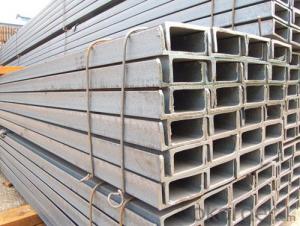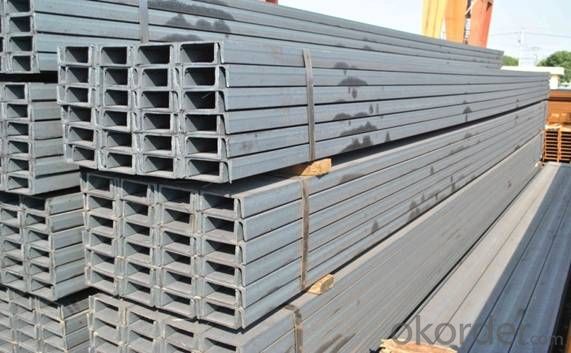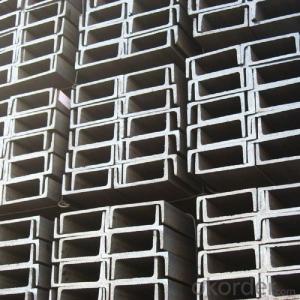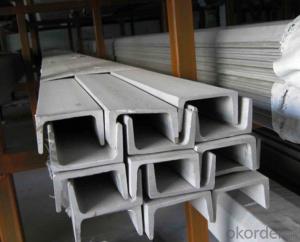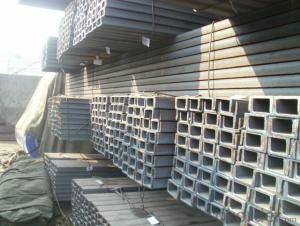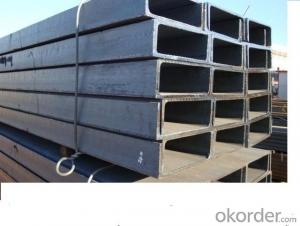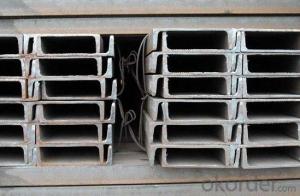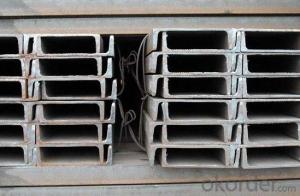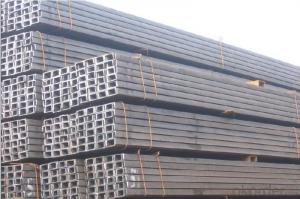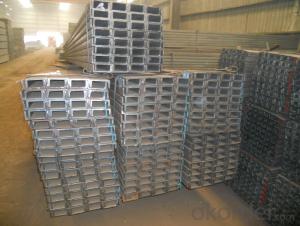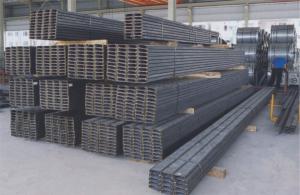GB Standard Steel Channel 100mm with High Quality
- Loading Port:
- China Main Port
- Payment Terms:
- TT or LC
- Min Order Qty:
- 25 m.t
- Supply Capability:
- 10000 m.t/month
OKorder Service Pledge
OKorder Financial Service
You Might Also Like
Product Description:
Specifications of GB Standard Steel Channel 100mm with High Quality:
1. We are definitely specializing in manufacturing and supplying channel steel.
| Standard: | GB/T 6723-86 |
| Sizes: | 50mm to 300mm |
| Sales Volume/Year: | 10000MT |
| Destination Area: | Middle East, Africa, Southeast Asia |
2.Size, Length and Mass of GB Standard Steel Channel 100mm with High Quality.
| Size(mm) | Length(m) | Mass(Kg/m) |
100*50*4 mm | 6m, 12m | 5.778 kg/m |
| 100*50*5 mm | 6m, 12m | 7.065 kg/m |
| 100*50*6 mm | 6m, 12m | 8.337 kg/m |
Package & Delivery of GB Standard Steel Channel 100mm with High Quality:
The steel u channel will be packed in bundle with steel wire at each end of every bundle and color marking in order to help the customer to recognize his goods more easily at sight.
And steel u channel could be loaded into 20ft or 40ft container, or by bulk cargo. If the weight of each bundle reaches less than 3.5 mt, the loading by break bulk cargo should be choosed. When the weight of each bundle reaches less than 3mt, the loading by container should be choosed.
As for the transportaion from mill to loading port, the truck will be usually used. And the maximum quantity for each truck is 40mt.
All in all, we could do in accordance with customer's request.
FAQ:
Q1: How soon can we receive the product after purchasement?
A1: Within three days of placing an order, we will begin production. The specific shipping date is dependent upon international and government factors, but is typically one month.
Q2: How do you guarantee the quality of our products?
A2: We have established an advanced quality management system which conducts strict quality tests at every step, from raw materials to the final product. At the same time, we provide extensive follow-up service assurances as required.
Q3: The prices are invoicing on theoritical weight or on actual weight?
A3: We can do it in both manners, according to the customers' request.
Images of GB Standard Steel Channel 100mm with High Quality:
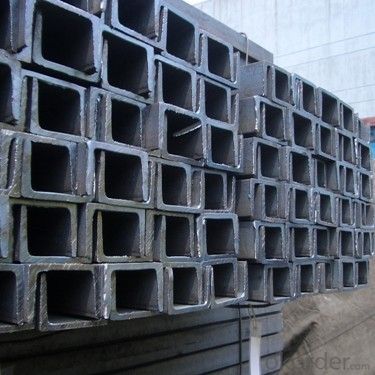
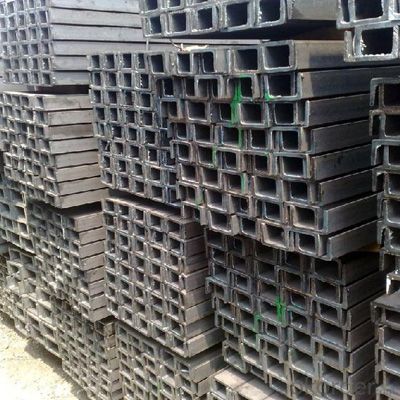
If you would like to get our price, please inform us the standard/material, size and quantity. Thank you very much.
- Q: Galvanized steel plate, channel steel, angle steel how to take samples, how to submit?
- Q235 pipe, PE pipe, 304L steel, stainless steel pipe, wire and cable approach, according to the same grade batch sampling representative or the same grade, the same approach specifications are to be inspected.
- Q: What are the different design considerations for steel channels in high-rise buildings?
- There are several important design considerations when it comes to steel channels in high-rise buildings. These considerations include structural integrity, load-bearing capacity, fire resistance, acoustics, and sustainability. Firstly, structural integrity is crucial in high-rise buildings as they are subjected to various loads such as dead loads, live loads, wind loads, and seismic loads. Steel channels need to be designed to withstand these loads and provide sufficient strength and stability to the structure. This involves selecting the appropriate channel size, thickness, and configuration to ensure the structural integrity of the building. Load-bearing capacity is another important consideration. Steel channels must be able to support the weight of the building and its contents. The load-bearing capacity is determined by factors such as the material properties of the steel, the size and shape of the channels, and the connection details. Proper design and analysis are essential to ensure that the steel channels can safely carry the required loads without any risk of failure. Fire resistance is a critical consideration in high-rise buildings. Steel channels need to be designed to withstand high temperatures and prevent the spread of fire. This can be achieved through the use of fire-resistant coatings or by incorporating fire-resistant materials into the design. Adequate fire protection measures, such as fireproofing or fire-rated enclosures, should also be considered to enhance the overall fire safety of the building. Acoustics is another important aspect to consider, especially in high-rise buildings where noise transmission can be a significant issue. Steel channels should be designed to minimize sound transmission and provide appropriate acoustic insulation. This can be achieved through the use of sound-absorbing materials, soundproofing techniques, or by incorporating specialized channel designs that reduce noise transmission. Lastly, sustainability is becoming an increasingly important consideration in building design. Steel channels can contribute to sustainability by using recycled materials, minimizing waste during fabrication, and providing long-term durability. Additionally, the design of steel channels should consider energy efficiency and the potential for future adaptability or reuse. In conclusion, the design considerations for steel channels in high-rise buildings include structural integrity, load-bearing capacity, fire resistance, acoustics, and sustainability. By carefully considering these factors, engineers can ensure the safety, functionality, and long-term performance of steel channels in high-rise construction projects.
- Q: A solar roof concrete foundation steel embedded parts, steel embedded parts are welded on the welding channel, two channel to head to head up, ask whether the welding part of a steel plate welding lining need? Or what other requirements? What norms do these requirements come from? Thank you
- 1, if two pieces of welding team gap is not conducive to welding, can be lined with a steel plate welding, if the assembly gap reasonable, direct rust removal, welding is ok.2, can use manual arc welding and J422 (E4303) welding rod can.
- Q: Can steel channels be used for equipment foundations?
- Yes, steel channels can be used for equipment foundations. Steel channels provide strength, durability, and stability, making them suitable for supporting heavy equipment and machinery. They can be designed to distribute weight evenly and withstand various loads, making them a reliable choice for equipment foundations.
- Q: After the type of channel is not marked A or B, which shall be calculated?
- For safety reasons, according to the A calculation, the weight of the material can be calculated according to B to avoid the insufficient use time
- Q: What are the specifications for steel channel coatings?
- The specific application and environment in which the steel channel will be used determine the varying specifications for its coatings. However, there are several commonly recommended coating specifications for steel channels. Firstly, the type of coating material is an important specification. Zinc-based galvanized coatings and epoxy coatings made from epoxy resins are commonly used for steel channels. These coatings protect against corrosion and enhance the channel's durability and longevity. Another crucial specification is the coating thickness, typically measured in microns. The required level of protection determines the coating thickness, which can vary. For instance, galvanized coatings usually have a thickness of approximately 20-40 microns, while epoxy coatings can range from 50-200 microns. Besides the coating material and thickness, other specifications may include adhesion properties, resistance to chemicals or abrasion, and the coating's color or appearance. These specifications are determined by the specific requirements of the application or industry in which the steel channel will be used. To ensure that the coating specifications for steel channels meet the desired level of protection and performance for the intended application, it is crucial to consult with a coating expert or follow industry standards and guidelines.
- Q: Are steel channels suitable for use in warehouse storage systems?
- Yes, steel channels are suitable for use in warehouse storage systems. They provide strong structural support and durability, making them ideal for storing heavy loads and maximizing storage capacity. Additionally, steel channels are versatile and can be easily customized to fit specific warehouse storage needs.
- Q: What are the different methods of finishing steel channels?
- There are several methods of finishing steel channels, including painting, galvanizing, powder coating, and applying a protective coating or plating. Each method offers different benefits and is chosen based on the desired appearance, durability, and environmental considerations.
- Q: What are the types of channel steels?
- Channel steel is divided into ordinary channel steel and light channel steel. Standard Specification for hot-rolled plain channel steel is 5-40#. Specifications for hot rolled flexible channel steel supplied by supply and demand agreement are 6.5-30#. Channel steel is mainly used in building structures, vehicle manufacturing and other industrial structures, and channel steel is often used in conjunction with i-beam.
- Q: How do steel channels perform under cyclic loading?
- Steel channels generally perform well under cyclic loading due to their inherent strength and durability. The unique shape of steel channels, with their flanges and web, provides structural stability and resistance to bending, shearing, and torsion forces. This makes them particularly suitable for applications where cyclic loading is present, such as in bridges, industrial buildings, and machinery. Under cyclic loading, steel channels exhibit a high fatigue strength, meaning they can withstand repeated loading and unloading cycles without significant deformation or failure. This is mainly due to the material properties of steel, which has a high elasticity and toughness. Steel channels also have a high resistance to corrosion, which further enhances their performance under cyclic loading conditions. Moreover, steel channels can be designed with specific dimensions and cross-sections to optimize their performance under cyclic loading. Engineers can calculate the required size and shape of the channel, taking into account factors such as the anticipated cyclic loading magnitude and frequency, as well as the material properties of the steel being used. This ensures that the steel channel can effectively distribute and withstand the cyclic loads, minimizing the risk of fatigue failure. However, it is important to note that the performance of steel channels under cyclic loading can be influenced by various factors, including the quality of the steel, the design and manufacturing process, and the installation and maintenance practices. Therefore, proper material selection, design considerations, and regular inspections are necessary to ensure the long-term performance and safety of steel channels under cyclic loading.
Send your message to us
GB Standard Steel Channel 100mm with High Quality
- Loading Port:
- China Main Port
- Payment Terms:
- TT or LC
- Min Order Qty:
- 25 m.t
- Supply Capability:
- 10000 m.t/month
OKorder Service Pledge
OKorder Financial Service
Similar products
Hot products
Hot Searches
Related keywords
